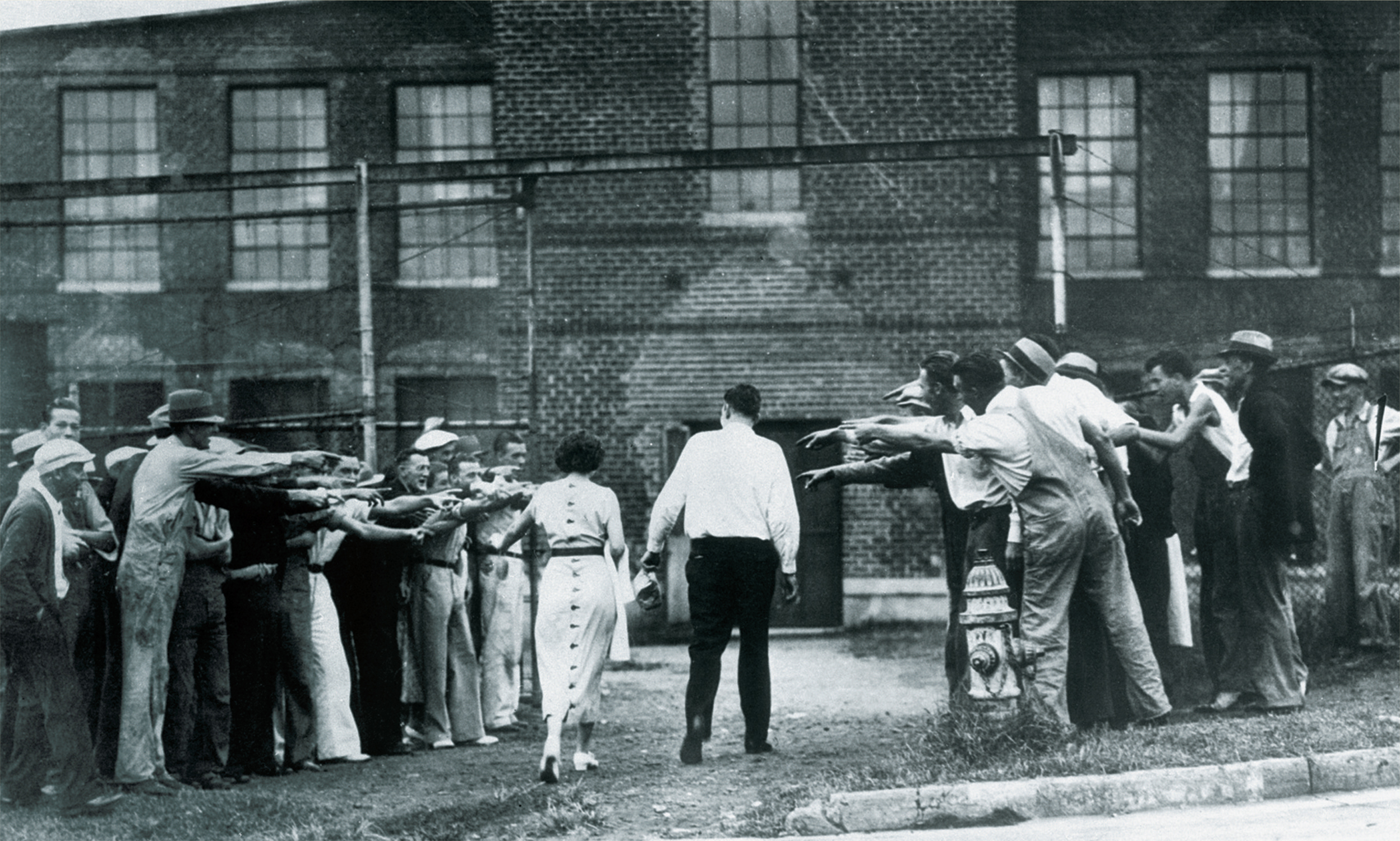Seeking the American Promise: “Textile Workers Strike for Better Wages and Working Conditions”

Striking Mill Workers Jeer Strikebreakers Textile workers on strike against the Cannon Textile Mills in North Carolina in September 1934 shouted taunts and curses at employees who refused to honor the strikers’ picket line. Why do you think strikers and strikebreakers wore different styles of clothing? Although thousands of women joined the strike, there are no women among the strikers shown here. Why might that be? © Bettmann/Corbis.
“The ‘Stretch-out System’ is the cause of the whole trouble,” a textile worker declared in 1930, echoing the sentiments of thousands of other mill workers. The “stretch-out” was the term coined by mill workers for the cost-cutting efficiencies implemented by mill owners that led to layoffs and poor working conditions for textile workers during the 1920s and 1930s. Textile manufacturers drastically increased the workload of their employees to cut labor costs and raise productivity. A mill worker who tended thirty looms in 1920 was responsible for ninety or more looms by 1929—if she or he still had a job. Layoffs of mill hands in the midst of the Great Depression contributed to further deterioration in wages and working conditions. So many people were desperate for work, no matter what the wage, that manufacturers were able to cut wages in half. The result, as one textile worker wrote Roosevelt, was that “the ones who are Still at Work are Being Treated as Bad or Worse tha[n] the Slaves were in Slavery times.”
Like so many other textile workers who faced the tough choice of working with the stretch-out or not working, Icy Norman was relieved to find work in 1929 at Burlington Mills in Piedmont Heights, North Carolina, where the supervisor happened to be a friend of her deceased father’s. He hired Norman to wind thread onto bobbins for weaving. At first, she earned only 15 cents a day, but as she became more skilled, her wages rose to $10 a week, a little over 15 cents an hour. “After I got used to being in there,” Norman recalled, “I really loved my work. . . . I got pleasure out of it and it made me happy to do my job.” Still, as one mill worker wrote to Roosevelt, “every textile worker in the South would walk out of the mill today if they were not afraid of starvation.”
In September 1934, hundreds of thousands of textile workers throughout the nation overcame their fears and walked out of the mills in the largest strike in American history. Strikers shut down mills from Maine to Alabama. More than half of all textile workers nationwide and about two-thirds of mill hands in the southern heartland of the textile industry walked out, including Icy Norman. Loosely organized by the Textile Workers’ Union, the strikers demanded better working conditions and wages through enforcement of the textile code established by the New Deal’s National Recovery Administration (NRA).
Like other NRA codes, the textile code was written and administered by the leading textile manufacturers. It provided for a maximum forty-hour workweek, a minimum weekly wage of $12 for southern mill hands, and the right of workers to organize unions. Textile workers celebrated the passage of the NRA in June 1933. “It seemed too good to be true,” one textile worker observed. Mill hands told a New Dealer, “We trust in the Supreme Being and Franklin Roosevelt. . . . [We] know that the President will see that [we] have work and proper wages; and that the stretchout will be abandoned.”
But their faith was misplaced, and the code was widely ignored. When workers complained that mill owners continued the stretch-out, cutting wages and firing any mill hands they suspected of union sympathies, their grievances were heard by the textile manufacturers who headed the NRA code authority. In the year before the strike, the textile code authority received nearly 4,000 complaints, investigated 96, and resolved just 1 in favor of a worker. Boiling with frustration over the failure of the textile code, more than 400,000 mill hands went on strike. Seeking to realize what they viewed as the unfulfilled promises of the New Deal’s NRA, they aimed to organize a union to bargain with mill owners to improve wages and working conditions.
The strike lasted three weeks and led to numerous violent confrontations with police and the National Guard. It ended because of the combination of the mill owners’ intransigence, the Textile Workers’ Union’s lack of resources, the mill workers’ increasingly desperate financial situation, and Roosevelt’s focus on the need for industrial peace to achieve economic recovery.
The mill hands achieved virtually nothing as a result of the strike. Mill owners continued to flout the textile codes, the stretch-out continued without interruption, and working conditions did not improve. Angry mill owners fired and blacklisted strike leaders, succeeding in their efforts to crush workers’ organizations.
Icy Norman went back to work after the strike ended, and since she was not a union activist, she managed to keep her job until she retired in 1976, after forty-seven years at Burlington Mills. For her efforts, the company rewarded her with a free visit to a local hairdresser, a tour of the Burlington executive suite, and a farewell handshake.
Questions for Consideration
- How did the stretch-out contribute to unemployment for textile workers?
- Why was textile workers’ faith in Roosevelt and NRA codes misplaced?
- Why do you think unions failed to organize textile workers when they succeeded in organizing autoworkers, for example?
In what ways did the New Deal affect industrial workers differently than farmers and other workers?
